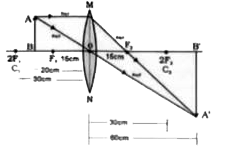Analyse the observation table which shows variation of image distance [v] with object distance [u] in the case of a convex lens. Answer the questions that follow without doing any calculations.
Sl.NoObject distanceImage distanceu [cm]v [cm]1−90+182−60+203−30+304−20+605−18+906−10+100
(a) What is the focal length of the convex lens ? Given reasons to support your answer.
(b) Write the Sl.No of the observation which is not correct.
How did you arrive at this conciusion ?
(c ) Use an appropriate scale to draw the ray diagram for the observation at Sl. No 4 and find the approximate value of magnification. Solution in Kannada
(a) When u=−30cm,v=+30cm. This indicates that the object is at C1 [which is 2F1]
r = 2f, 30 = 2f, f = 15 cm
Focal length of the convex lens is + 15 cm.
(b) If Object distance u=−10cm, it means the object is placed between the optic centre and focus, a virtual erect image formed in this case on the same side as the object. Therefore v should be negative according to Cartesian sign convention ie.,
v=−100cm and not v=+100 cm as mentioned in the table.
Therefore SI. No 6 is incorrect.
(c ) SI. No 4 u=−20cm,v=+60cmF1=−15cm2F1=−30cm
The object is between F1 and 2F1, an enlarged real and inverted image is formed beyond 2F,

Magnification =m=vu=(+60)(−20)=−3
Topper's Solved these Questions
- LIGHT - REFLECTION AND REFRACTIONBOOK - ZEN PUBLICATIONCHAPTER - LIGHT - REFLECTION AND REFRACTIONEXERCISE - ZEN ADDITIONAL QUESTIONS SECTION (SHORT ANSWER [SA] TYPE - II QUESTIONS)
34 Videos
- ELECTRICITYBOOK - ZEN PUBLICATIONCHAPTER - ELECTRICITYEXERCISE - ZEN ADDITIONAL QUESTIONS SECTION (MULTIPLE CHOICE QUESTIONS)
60 Videos
- MAGNETIC EFFECTS OF ELECTRIC CURRENT BOOK - ZEN PUBLICATIONCHAPTER - MAGNETIC EFFECTS OF ELECTRIC CURRENT EXERCISE - Additional question section (Higher-order thinking skills [HOTS] questions)
20 Videos
Similar Questions
How is the refractive index of a medium related to the speed of light ? Obtain an expression for refractive index of a medium with respect to another in terms of speed of light in these two media ?
View SolutionA cell, a resistor, a key and ammeter are arranged as shown in the circuit diagrams. The current recorded in the ammeter will be

View SolutionWhich of the following is true ?
View SolutionThe image obtained with a convex lens is erect and its length is 4 times the length of the object. If the focal length of lens is 20 cm , calculate the object and image distances.
View SolutionThe image obtained with a convex lens is erect and its length is 4 times the length of the object. If the focal length of lens is 20cm, calculate the object and image distances.
View Solutionएक उत्तल लेंस (convex lens) से 30 cm की दूरी पर रखी एक वस्तु का वास्तविक प्रतिबिम्ब (real image) लेंस से 20 cm की दूरी पर बनता है लेंस की फोकस-दूरी (focal lenght) निकाले
View SolutionThe focal length of convex lens is 20 cm. If an object of height 4 cm is placed at a distance of 30 cm from the lens, find: The position of the image
View SolutionThe focal length of convex lens is 20 cm. If an object of height 4 cm is placed at a distance of 30 cm from the lens, find:
The height of the image
View SolutionAn object is placed at a distance of 15 cm from a convex lens. If the focal length of the lens is 60 cm, find the image distance.
View SolutionAn object is placed at a distance 20 cm from a convex lens of focal length 10 cm . Find the image distance and nature of the image .
View SolutionAnalyse the observation table which shows variation of image distance [v] with object distance [u] in the case of a convex lens. Answer the questions that follow without doing any calculations. {:("Sl.No","Object distance","Image distance"),(,"u [cm]","v [cm]"),(1,-90,+18),(2,-60,+20),(3,-30,+30),(4,-20,+60),(5,-18,+90),(6,-10,+100):} (a) What is the focal length of the convex lens ? Given reasons to support your answer. (b) Write the Sl.No of the observation which is not correct. How did you arrive at this conciusion ? (c ) Use an appropriate scale to draw the ray diagram for the observation at Sl. No 4 and find the approximate value of magnification.
View SolutionAnalyse the following observation table showing variation of image-distance (v) with object-distance (u) in case of a convex lens and answer the questions that follow without doing any calculations :
S.No.Object-distanceImage-distanceu (cm)v (cm)1−100+252−60+303−40+404−30+605−25+1006−15+120
(a) What is the focal length of the convex lens ? Give reason to justify your answer.
(b) Write the seril number of the observation which is not correct. On what basis have you arrived at this conclusion ?
(c) Select an appropriate scale and draw a ray diagram for the observation at S.NO. 2. Also find the approximate value of magnification.
View SolutionThe image obtained with a convex lens is erect and its length is 4 times the length of the object. If the focal length of lens is 20cm, calculate the object and image distances.
View SolutionA convex lens of focal lengths 30 cm produces 5 times magnified real image of an object What is the object distance ?
View SolutionAn object of height 3 cm is placed in front of a convex lens of focal length 20 cm at a distance of 30 cm.
What is the distance to the image formed ?
View Solution
